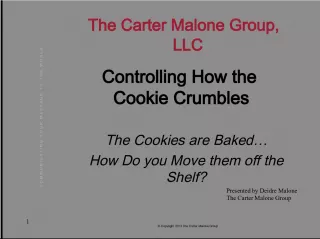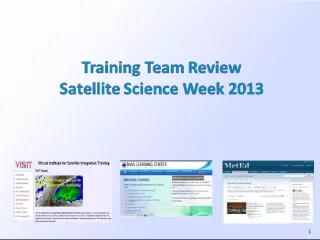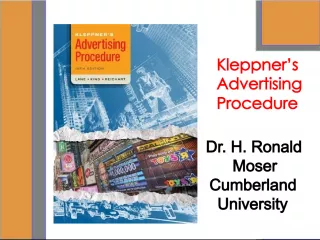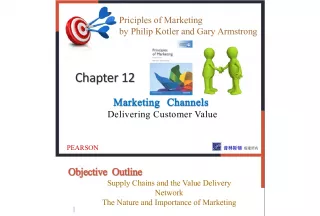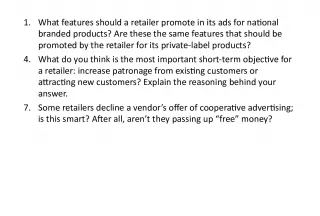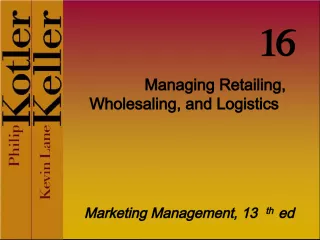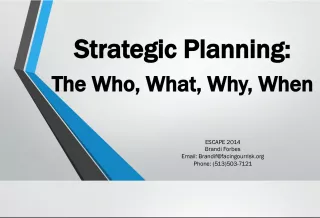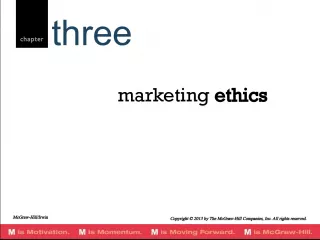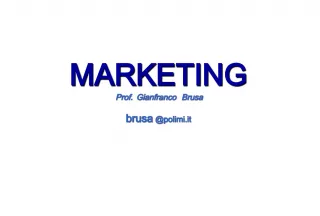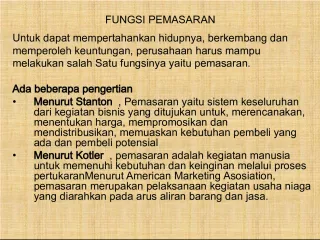Building a Strategic Marketing Framework: Elements and Strategies
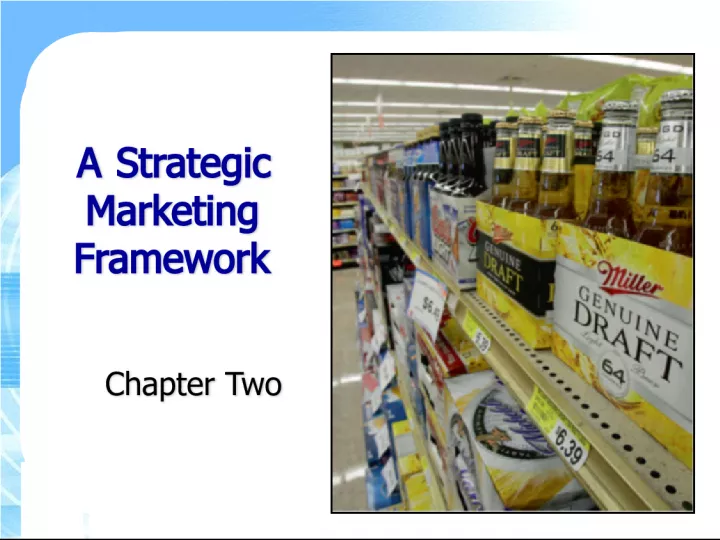

This chapter discusses the key learning points of developing a marketing strategy including creating a value proposition, sustainable competitive advantage, positioning products, and product life cycle analysis. The framework provided helps businesses build effective marketing plans.
- Uploaded on | 26 Views
-
 buggi
buggi
About Building a Strategic Marketing Framework: Elements and Strategies
PowerPoint presentation about 'Building a Strategic Marketing Framework: Elements and Strategies'. This presentation describes the topic on This chapter discusses the key learning points of developing a marketing strategy including creating a value proposition, sustainable competitive advantage, positioning products, and product life cycle analysis. The framework provided helps businesses build effective marketing plans.. The key topics included in this slideshow are marketing strategy, value proposition, competitive advantage, product positioning, product life cycle analysis,. Download this presentation absolutely free.
Presentation Transcript
1. A Strategic Marketing Framework A Strategic Marketing Framework Chapter Two Chapter Two
2. Copyright 2011 Pearson Education, Inc., Publishing as Prentice Hall 1-2 Key Learning Points Key Learning Points The elements of a complete marketing strategy The elements of a complete marketing strategy Developing a value proposition Developing a value proposition Developing a sustainable competitive advantage Developing a sustainable competitive advantage Positioning products and services Positioning products and services The product life cycle and how it affects marketing strategies The product life cycle and how it affects marketing strategies
3. Copyright 2011 Pearson Education, Inc., Publishing as Prentice Hall 1-3 Figure 2.1 A Complete Marketing Strategy Figure 2.1 A Complete Marketing Strategy
4. Copyright 2011 Pearson Education, Inc., Publishing as Prentice Hall 1-4 Marketing Strategy Marketing Strategy Objectives: Objectives: Mission statements Mission statements Corporate objectives Corporate objectives Business unit / divisional objectives Business unit / divisional objectives Objectives geared towards increasing profit AND increasing market share require trade-offs. Objectives geared towards increasing profit AND increasing market share require trade-offs.
5. Copyright 2011 Pearson Education, Inc., Publishing as Prentice Hall 1-5 Activity Activity At which strategic level would you expect to find the following objectives: At which strategic level would you expect to find the following objectives: Achieve a 2% coupon redemption rate for Product X by June 30 th of this year Achieve a 2% coupon redemption rate for Product X by June 30 th of this year Maximize shareholder wealth Maximize shareholder wealth Increase market share within the detergent product category by 1% for the 2011 fiscal year Increase market share within the detergent product category by 1% for the 2011 fiscal year
6. Copyright 2011 Pearson Education, Inc., Publishing as Prentice Hall 1-6 Marketing Strategy Marketing Strategy Characteristics of well-written objectives: Characteristics of well-written objectives: Lists a quantified standard of performance. Lists a quantified standard of performance. Designates a clear time frame. Designates a clear time frame. States goal in measurable terms. States goal in measurable terms. Should be challenging but realistic. Should be challenging but realistic.
7. Copyright 2011 Pearson Education, Inc., Publishing as Prentice Hall 1-7 Marketing Strategy Marketing Strategy Customer and competitor targets: Customer and competitor targets: Which customer group should be targeted? Which customer group should be targeted? Select a general strategy. Select a general strategy. Define targeted group in more precise terms. Define targeted group in more precise terms.
8. Copyright 2011 Pearson Education, Inc., Publishing as Prentice Hall 1-8 Figure 2.2 Strategic Alternatives Figure 2.2 Strategic Alternatives
9. Copyright 2011 Pearson Education, Inc., Publishing as Prentice Hall 1-9 Marketing Strategy Marketing Strategy Market penetration strategy: Market penetration strategy: Targeting the firms own customers is a high priority. Targeting the firms own customers is a high priority. Targeting customers of the competition is riskier and more expensive strategy. Targeting customers of the competition is riskier and more expensive strategy. Common in slow growth markets. Common in slow growth markets. Price promotions are key. Price promotions are key.
10. Copyright 2011 Pearson Education, Inc., Publishing as Prentice Hall 1-10 Discussion Discussion Pricing promotions encourage people to switch brands, at least temporarily. Pricing promotions encourage people to switch brands, at least temporarily. Give an example of a pricing promotion that may result in longer- term switching behavior, and explain why. Give an example of a pricing promotion that may result in longer- term switching behavior, and explain why.
11. Copyright 2011 Pearson Education, Inc., Publishing as Prentice Hall 1-11 Marketing Strategy Marketing Strategy Market development strategies: Market development strategies: Targeting new customers in new segments. Targeting new customers in new segments. Will it require the introduction of new or modified products? Will it require the introduction of new or modified products? Targeting nonbuying customers in currently served segments. Targeting nonbuying customers in currently served segments. Is it profitable? Is it profitable?
12. Copyright 2011 Pearson Education, Inc., Publishing as Prentice Hall 1-12 Discussion Question Discussion Question Many products have successfully used packaging innovations, such as the squeeze container, to appeal to new markets by providing a functional benefit. Many products have successfully used packaging innovations, such as the squeeze container, to appeal to new markets by providing a functional benefit. 1. What are other examples of packaging innovations that have been used to attract new users to a brand? 2. Give an example of how a particular product could be modified to attract new users.
13. Copyright 2011 Pearson Education, Inc., Publishing as Prentice Hall 1-13 Marketing Strategy Marketing Strategy Market Development Strategies: Entering Foreign Markets: Market Development Strategies: Entering Foreign Markets: Requires decisions related to Requires decisions related to The choice of country or countries to enter. The choice of country or countries to enter. The timing of the entry. The timing of the entry. How to operate in the chosen countries. How to operate in the chosen countries. Five factors should be considered when deciding how to enter a foreign market. Five factors should be considered when deciding how to enter a foreign market.
14. Copyright 2011 Pearson Education, Inc., Publishing as Prentice Hall 1-14 Figure 2.3 Factors Affecting Mode of Entry Figure 2.3 Factors Affecting Mode of Entry
15. Copyright 2011 Pearson Education, Inc., Publishing as Prentice Hall 1-15 Table 2.1 Global Purchasing Power Indices (U.S. = 100) Table 2.1 Global Purchasing Power Indices (U.S. = 100)
16. Copyright 2011 Pearson Education, Inc., Publishing as Prentice Hall 1-16 Marketing Strategy Marketing Strategy The value proposition: The value proposition: Summarizes into a single paragraph Summarizes into a single paragraph The customer. The customer. The competitive targets. The competitive targets. The customers reason for buying your brand. The customers reason for buying your brand. Forms the basis for the marketing mix. Forms the basis for the marketing mix.
17. Copyright 2011 Pearson Education, Inc., Publishing as Prentice Hall 1-17 For (target segment n), the (product/ brand name) is a (product category) that unlike (competitor targets), (statement of primary differentiation). For men aged 20 29, Thums Up is a cola that unlike Coke and Pepsi, has Indian heritage, tastes spicier, and tastes just as good warm as it does cold. For men aged 20 29, Thums Up is a cola that unlike Coke and Pepsi, has Indian heritage, tastes spicier, and tastes just as good warm as it does cold. Model of a Value Proposition Model of a Value Proposition
18. Copyright 2011 Pearson Education, Inc., Publishing as Prentice Hall 1-18 Competitive advantage the strategic development of some basis on which customers will choose a firms product or service over its competitors. Competitive advantage the strategic development of some basis on which customers will choose a firms product or service over its competitors. - Russell S. Winer
19. Copyright 2011 Pearson Education, Inc., Publishing as Prentice Hall 1-19 Marketing Strategy Marketing Strategy Differentiation: Differentiation: Competitive advantages (CA) should have three characteristics: Competitive advantages (CA) should have three characteristics: Competitive advantage should generate customer value. Competitive advantage should generate customer value. Increased value must be perceived by the consumer. Increased value must be perceived by the consumer. Competitive advantage should be difficult to copy. Competitive advantage should be difficult to copy.
20. Copyright 2011 Pearson Education, Inc., Publishing as Prentice Hall 1-20 Marketing Strategy Marketing Strategy General Approaches to Creating Competitive Advantage General Approaches to Creating Competitive Advantage Cost-based or price-based advantage Cost-based or price-based advantage Quality-based or differentiation advantage Quality-based or differentiation advantage Perceived quality or brand-based advantage Perceived quality or brand-based advantage
21. Copyright 2011 Pearson Education, Inc., Publishing as Prentice Hall 1-21 Marketing Strategy Marketing Strategy Cost- or Price-Based Advantage: Cost- or Price-Based Advantage: Managers choose whether or not to compete on basis of price. Managers choose whether or not to compete on basis of price. Difficult to achieve, but two primary methods exist: Difficult to achieve, but two primary methods exist: Becoming the largest producer and benefiting from economies of scale. Becoming the largest producer and benefiting from economies of scale. Taking advantage of the experience curve. Taking advantage of the experience curve.
22. Copyright 2011 Pearson Education, Inc., Publishing as Prentice Hall 1-22 Figure 2.4 Learning Curves for Software and Hardware Figure 2.4 Learning Curves for Software and Hardware
23. Copyright 2011 Pearson Education, Inc., Publishing as Prentice Hall 1-23 Marketing Strategy Marketing Strategy Cost- or Price-Based Advantage: Cost- or Price-Based Advantage: Firms who are not industry leaders or who lack experience can also succeed. Firms who are not industry leaders or who lack experience can also succeed. Strict cost control and flexible manufacturing can help to develop a cost-based advantage. Strict cost control and flexible manufacturing can help to develop a cost-based advantage. Examples: Examples: IKEA IKEA Jiffy Lube Jiffy Lube Vanguard Group Vanguard Group
24. Copyright 2011 Pearson Education, Inc., Publishing as Prentice Hall 1-24 Marketing Strategy Marketing Strategy Quality-Based Differentiation: Quality-Based Differentiation: Develops an observable difference that is valued by customers. Develops an observable difference that is valued by customers. Typically implies higher costs. Typically implies higher costs. Allows for both higher prices and higher margins. Allows for both higher prices and higher margins. Differentiation can occur at any point within the value chain. Differentiation can occur at any point within the value chain.
25. Copyright 2011 Pearson Education, Inc., Publishing as Prentice Hall 1-25 Illustration Illustration Sun Microsystems differentiates its products by having its own operating system, Solaris. Sun Microsystems differentiates its products by having its own operating system, Solaris.
26. Copyright 2011 Pearson Education, Inc., Publishing as Prentice Hall 1-26 Marketing Strategy Marketing Strategy Differentiation Opportunities Within the Value Chain Differentiation Opportunities Within the Value Chain Inbound Logistics Inbound Logistics Operational Advantages Operational Advantages Outbound Logistics Outbound Logistics Marketing & Sales Marketing & Sales Services Services
27. Copyright 2011 Pearson Education, Inc., Publishing as Prentice Hall 1-27 Marketing Strategy Marketing Strategy Perceived Quality or Brand-Based Differentiation: Perceived Quality or Brand-Based Differentiation: Appropriate when actual differences are small, hard to achieve, or difficult to sustain. Appropriate when actual differences are small, hard to achieve, or difficult to sustain. Marketing mix decisions contribute to brand-based differentiation. Marketing mix decisions contribute to brand-based differentiation. Perceptual maps can help in understanding consumer perceptions. Perceptual maps can help in understanding consumer perceptions.
28. Copyright 2011 Pearson Education, Inc., Publishing as Prentice Hall 1-28 Figure 2.5 Perceptual Map for Retail Banks Figure 2.5 Perceptual Map for Retail Banks
29. Copyright 2011 Pearson Education, Inc., Publishing as Prentice Hall 1-29 Activity Activity What two attributes or dimensions did YOU consider most important when comparing competing Universities? What two attributes or dimensions did YOU consider most important when comparing competing Universities? Dimension B Dimension A
30. Copyright 2011 Pearson Education, Inc., Publishing as Prentice Hall 1-30 One of the key ways to define a perceptual differential advantage is through the brand name. The value of a brand name in communicating quality or other aspects of the product is called brand equity . One of the key ways to define a perceptual differential advantage is through the brand name. The value of a brand name in communicating quality or other aspects of the product is called brand equity . - Russell S. Winer
31. Copyright 2011 Pearson Education, Inc., Publishing as Prentice Hall 1-31 Illustration Illustration Bayers strong brand name provides differentiation against generics and private label (store) brands. Strength of brand name relates to which element within the value chain ? Bayers strong brand name provides differentiation against generics and private label (store) brands. Strength of brand name relates to which element within the value chain ?
32. Copyright 2011 Pearson Education, Inc., Publishing as Prentice Hall 1-32 Marketing Strategy Marketing Strategy Core Strategy: Positioning Core Strategy: Positioning A point of differentiation must be selected for communication. A point of differentiation must be selected for communication. Positioning creates a clear image in the mind of the consumer of what the product stands for and how it is different from competitive offerings. Positioning creates a clear image in the mind of the consumer of what the product stands for and how it is different from competitive offerings.
33. Copyright 2011 Pearson Education, Inc., Publishing as Prentice Hall 1-33 Marketing Strategy Marketing Strategy Formulating the positioning strategy requires knowledge of: Formulating the positioning strategy requires knowledge of: The dimensions used by consumers to evaluate products. The dimensions used by consumers to evaluate products. The importance of each dimension. The importance of each dimension. Comparisons of the brand and competition. Comparisons of the brand and competition. The decision processes used by consumers. The decision processes used by consumers. Sometimes repositioning is necessary. Sometimes repositioning is necessary.
34. Copyright 2011 Pearson Education, Inc., Publishing as Prentice Hall 1-34 Marketing Strategy Marketing Strategy Marketing Mix: Marketing Mix: Implementation of the marketing mix makes the strategy operational. Implementation of the marketing mix makes the strategy operational. Consistency between strategy and the actual implementation is critical. Consistency between strategy and the actual implementation is critical.
35. Copyright 2011 Pearson Education, Inc., Publishing as Prentice Hall 1-35 Figure 2.6 Ensuring a Segment-Focused Strategy Figure 2.6 Ensuring a Segment-Focused Strategy
36. Copyright 2011 Pearson Education, Inc., Publishing as Prentice Hall 1-36 Discussion Discussion Dell manufactures products for the home user segment, small and medium business market, the public sector (government, education), and for large enterprise. Dell manufactures products for the home user segment, small and medium business market, the public sector (government, education), and for large enterprise. In what ways might the core strategy or marketing mix differ when catering to each segment? Explain. In what ways might the core strategy or marketing mix differ when catering to each segment? Explain.
37. Copyright 2011 Pearson Education, Inc., Publishing as Prentice Hall 1-37 Figure 2.7 The Product Life Cycle Figure 2.7 The Product Life Cycle
38. Copyright 2011 Pearson Education, Inc., Publishing as Prentice Hall 1-38 The Product Life Cycle (PLC) sketches the sales history of a product category over time. The Product Life Cycle (PLC) sketches the sales history of a product category over time. This conceptual tool is best applied to product categories and not to specific brands. This conceptual tool is best applied to product categories and not to specific brands. Strategy options and the importance of marketing mix variables vary across each stage of the PLC. Strategy options and the importance of marketing mix variables vary across each stage of the PLC. Not all product categories follow the standard PLC curve. Not all product categories follow the standard PLC curve. Marketing Strategies Over the Product Life Cycle Marketing Strategies Over the Product Life Cycle
39. Copyright 2011 Pearson Education, Inc., Publishing as Prentice Hall 1-39 Figure 2.8 VCR Deck Sales to Dealers Figure 2.8 VCR Deck Sales to Dealers
40. Copyright 2011 Pearson Education, Inc., Publishing as Prentice Hall 1-40 Marketing Strategies Over the Product Life Cycle Marketing Strategies Over the Product Life Cycle Market size and growth rate are low. Market size and growth rate are low. Product: one brand that pioneered the category Product: one brand that pioneered the category Selling & advertising: focuses on generic product Selling & advertising: focuses on generic product Pricing: penetration or skimming Pricing: penetration or skimming Distribution: limited as product is unproven Distribution: limited as product is unproven Often offers a first- mover advantage Often offers a first- mover advantage Introduction Stage Introduction Stage
41. Copyright 2011 Pearson Education, Inc., Publishing as Prentice Hall 1-41 Marketing Strategies Over the Product Life Cycle Marketing Strategies Over the Product Life Cycle Competition grows. Competition grows. Price pressures increase. Price pressures increase. Communications stress differentiation. Communications stress differentiation. Distribution pressures increase. Distribution pressures increase. Market segmentation becomes necessary. Market segmentation becomes necessary. Growth Stage Growth Stage
42. Copyright 2011 Pearson Education, Inc., Publishing as Prentice Hall 1-42 Growth Stage Strategic Options Growth Stage Strategic Options Fight (maintain) Fight (maintain) Fight (enhance) Fight (enhance) Flee (give up market leadership) Flee (give up market leadership) Exit the market Exit the market Imitate the leader Imitate the leader Fortify position Fortify position Leapfrog the competition Leapfrog the competition Market Leader: Market Leader: Market Follower: Market Follower: Marketing Strategies Over the Product Life Cycle Marketing Strategies Over the Product Life Cycle
43. Copyright 2011 Pearson Education, Inc., Publishing as Prentice Hall 1-43 Marketing Strategies Over the Product Life Cycle Marketing Strategies Over the Product Life Cycle Few new buyers Few new buyers Sophisticated consumers Sophisticated consumers Well-defined segments Well-defined segments Differential advantage sought Differential advantage sought Maturity Stage Maturity Stage
44. Copyright 2011 Pearson Education, Inc., Publishing as Prentice Hall 1-44 Maturity Stage Strategic Options Maturity Stage Strategic Options Invest enough to maintain position Invest enough to maintain position Harvest cash for short-term Harvest cash for short-term Depends, but may: Depends, but may: Pursue #1 Pursue #1 Stay #2. Stay #2. Exit category Exit category Market Leader Market Leader Market Follower Market Follower Marketing Strategies Over the Product Life Cycle Marketing Strategies Over the Product Life Cycle
45. Copyright 2011 Pearson Education, Inc., Publishing as Prentice Hall 1-45 Decline Stage Strategic Options Decline Stage Strategic Options Marketing Strategies Over the Product Life Cycle Marketing Strategies Over the Product Life Cycle Strategically revive by applying strategies during maturity phase. Strategically revive by applying strategies during maturity phase. Serendipity may revive the category. Serendipity may revive the category. Consciously decide to be the Last Iceman. Consciously decide to be the Last Iceman.
46. Copyright 2011 Pearson Education, Inc., Publishing as Prentice Hall 1-46 There are no mature markets, only tired marketers. There are no mature markets, only tired marketers. - Campbell Soup CEO, David Johnson
47. Copyright 2011 Pearson Education, Inc., Publishing as Prentice Hall 1-47 Figure 2.9 Beer Market Evolution for Selected Countries and Regions Figure 2.9 Beer Market Evolution for Selected Countries and Regions
48. Copyright 2011 Pearson Education, Inc., Publishing as Prentice Hall 1-48 Executive Summary Executive Summary Marketing strategies contain many parts. Marketing strategies contain many parts. Value propositions should be concise. Value propositions should be concise. Three key methods can lead to differential advantage. Three key methods can lead to differential advantage. Product positioning is essential. Product positioning is essential. Strategic alternatives vary with the stage of product life cycle. Strategic alternatives vary with the stage of product life cycle.
49. Copyright 2011 Pearson Education, Inc., Publishing as Prentice Hall 1-49 All rights reserved. No part of this publication may be reproduced, stored in a retrieval system, or transmitted, in any form or by any means, electronic, mechanical, photocopying, recording, or otherwise, without the prior written permission of the publisher. Printed in the United States of America.
